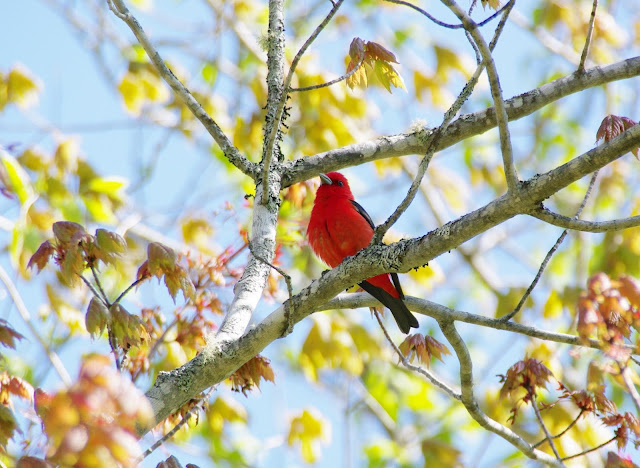Four Common and Two Rare Species
 |
| Red-eyed Vireo |
Birders in New Brunswick could possibly see six species of vireos. But what is a vireo? A vireo is a small insectivorous bird. It is slightly larger than a warbler and is usually quite vocal. So, we often hear them before we see them. They live in the foliage of large trees, usually deciduous, where they find plenty of insects and their larvae to feed themselves and their young.
Vireos look much like warblers but they are actually closely related to shrikes. They are typically gray or green above and white or yellow below. When trying to identify them, watch for the presence or absence of wing bars, eye rings or spectacles, eye lines, eye brows, and in some cases the eye colour. We have six species of vireos, four of which are common. Three species have wing bars; Blue-headed Vireo, Yellow-throated Vireo, and White-eyed Vireo. Three species do not have wing bars; Red-eyed Vireo, Philadelphia Vireo and Warbling Vireo. The two rare species are Yellow-throated Vireo and White-eyed Vireo.
The Red-eyed Vireo, seen above, is probably our most common species. It can be heard almost anywhere in the province during summer, singing almost incessantly from hardwood trees. It has a red eye, a white eye brow with a dark line above it and a dark line through the eye. It is one of our most common summer birds. It is said the male sings to the female while she is on the nest in order to keep her brooding. That explains the persistent song.
The Blue-headed Vireo is also very common. It is found in mixed woods. Its song is similar to that of the Red-eyed but slower in tempo. The head is a nice blue-gray colour and the white spectacles are very evident.
 |
| Blue-headed Vireo |
The Philadelphia Vireo prefers open woodlands and thickets near streams. Its song is similar to that of the Red-eyed but slower, thinner and higher pitched. It has a white eyebrow with a dark eye line and its body is mainly green above and yellow below.
 |
| Philadelphia Vireo |
The Warbling Vireo is a wonderful songster. Its song is characterized by long melodious phrases. It is our plainest-looking vireo, being dull gray or greenish above and whitish/yellowish below. It has a whitish eyebrow which lacks a dark upper border and there is no strong eye line. It likes deciduous forests especially riparian areas.
 |
Warbling Vireo [Internet Photo]
|
The Yellow-throated Vireo is uncommon in NB. Its yellow is shockingly bright. Its yellow spectacles are distinctive. The dark grey wings and white wing bars make it easy to identify. It prefers deciduous and mixed woods.
 |
| Yellow-throated Vireo [Internet Photo] |
The White-eyed Vireo is rare here. Its yellow spectacles and white eye are distinctive. Its "explosive song from a thicket or tangle of vines" (National Geographic Birds of North America) identifies this bird. That is exactly what I discovered the first time I ever saw this species. It was making strange sounds from a thicket and would not show itself. Only by persistence did I get to see this bird! It is seen occasionally here during migration.
 |
| White-eyed Vireo [Internet Photo] |





















